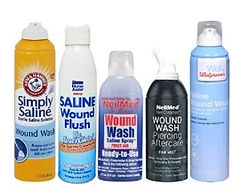-1.jpg)
MIDLAND
MICHIGAN
-1.jpg)

Piercing CARE
Your piercer cleaned and disinfected the area pierced, and used sterile piercing equipment and jewelry. Now it's up to you to take appropriate care of your piercing.

Products you can use
1. Sterile saline solution helps maintain your natural balance and promotes quick healing. The easiest and safest saline is sterile Wound Wash saline (also available at grocery and drug stores). It is sold in a pressurized can. Do not purchase antibiotic saline, contact cleaning solutions, or soaking/enzyme solutions.
2. Single use gauze or clean paper towels.

what to avoid
Chemicals will not help you heal faster.
Avoid cleaning with alcohol, hydrogen peroxide, antibacterial soap, or any other harsh products. Avoid ear care solutions (benzalkonium/benzethonium chloride) or any other product containing an “active ingredient.” Do not use antibiotic ointment (or any other petroleum-based ointments) as they prevent necessary air circulation.
Avoid playing with jewelry.
Physical irritation due to unnecessary touch is the most frequently seen problem. This can cause formation of unsightly and uncomfortable scar tissue, migration, prolonged healing, and other complications. Also avoid friction from clothing. When clothing will cover a new piercing, wear clean, loose fabric. Let your new piercing breathe!
Avoid sleeping on fresh ear piercings. This can cause painful swelling, migration, and irritation bumps amongst other problems.
Pro tip: take the pressure off a new piercing by using a travel pillow to cradle your ear while you sleep!
Avoid submerging the piercing in unhygienic bodies of water such as lakes, pools, hot tubs, etc. for a minimum of 6 weeks while healing.
Avoid all beauty and personal care products on or around the piercing. This includes cosmetics, moisturizer, sunscreen or any other lotion or spray. Pro tip: when styling hair, fold a clean paper towel around the ear to prevent contact with hairspray.
Avoid oral contact, rough play, and contact with others’ bodily fluids on or near your piercing during healing.
other helpful
information
Unless there is a problem with the size, style or material of the initial jewelry, leave it in place for the entire healing period. See a qualified piercer to perform any jewelry change that becomes necessary during healing.
With clean hands or a paper product, be sure to regularly check threaded ends on your jewelry for tightness (“righty-tighty, lefty-loosey”).
Infection: Often, people who think they have an infection actually have irritation and adjusting the care will fix the problem. Some signs of infection are a sudden inflammation, hot/red tissue surrounding the piercing, and a discharge of discolored pus and/or blood. In the event an infection is suspected, contact your body piercer or your doctor at once. Do not wait for it to get worse, and do not attempt a home remedy.
Healing time for most piercings ranges from 2 to 4 months. Expect new piercings to be sore for a few weeks, and if there isn’t a marked improvement after that time, contact your piercer for evaluation and advice.
Should you decide you no longer want the piercing, simply remove the jewelry or see a professional piercer for assistance. Continue cleaning the piercing until the hole closes. In most cases, only a small mark should remain.
How to care for your piercing
ALWAYS WASH YOUR HANDS BEFORE TOUCHING YOUR BODY PIERCING!
CLEANING INSTRUCTIONS:
-
SALINE cleanse to remove any accumulated lymph (“crusties”) from the exposed jewelry and surrounding skin. Spray saline directly on both sides of the piercing. To remove particularly stubborn crusties, soak a gauze pad or clean paper towel with saline and gently wipe the skin or jewelry clean. There is no need to turn the jewelry or intentionally work the saline inside the piercing; the less movement, the happier the piercing!
-
DRY by gently patting with clean paper towel. Avoid cloth towels as they can harbor bacteria and snag on jewelry, causing injury.
-
Follow these instructions twice a day while healing, and anytime the piercing feels “sticky” or uncomfortable.
There is no need to turn the jewelry or intentionally work the saline inside the piercing; the less movement, the happier the piercing!
DOWNSIZING
As a courtesy we offer a discount on downsize appointments made within 6 weeks of your original appointment. If made after the 6 weeks, it would be full price with any additional fees. Downsizes are done by appointment only on Tue. – Thur. Piercings that are improperly cared for or placed in areas advised against by the piercer may not qualify for a discounted downsize. You must give 24-hour notice to change an appointment. No call / no show will result in loss of discount and to rebook it will have to be paid in full.

what is normal?
Initially: some bleeding, localized swelling, tenderness and/or bruising.
During healing: some discoloration, itching, secretion of a whitish-yellow fluid (not pus) that will form some crust on the jewelry. The tissue may tighten around the jewelry as it heals.
Once healed: the jewelry may not move freely in the piercing; do not force it. If you fail to include cleaning your piercing as part of your daily hygiene routine, normal but smelly bodily secretions may accumulate.
A piercing might seem healed before the healing process is complete. This is because tissue heals from the outside in, and although it feels fine, the interior remains fragile. Be patient and keep cleaning throughout the entire initial healing period.
Even healed piercings you have had for years can shrink or close in minutes! This varies from person to person; if you like your piercing, keep jewelry in – do not leave the hole empty.

Expert advice
Do not accept advice from your friends, parents, friends’ parents, acquaintances, relatives or psychic mediums regarding the care of your piercings. Do not consult the internet, for it is dark and full of terrors. If you need help, advice or assistance with your piercing, contact the professionals at Black Ball Tattoo.